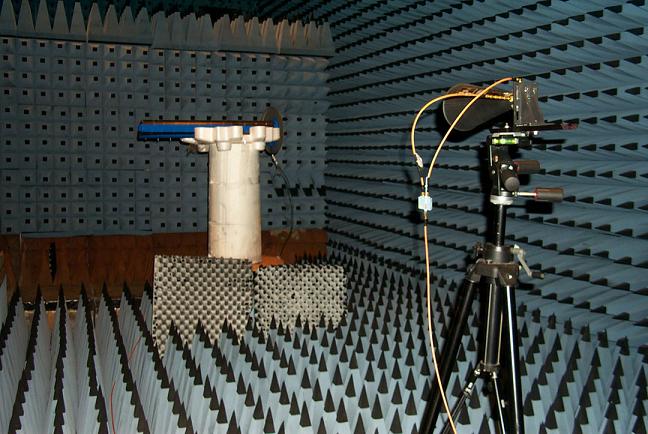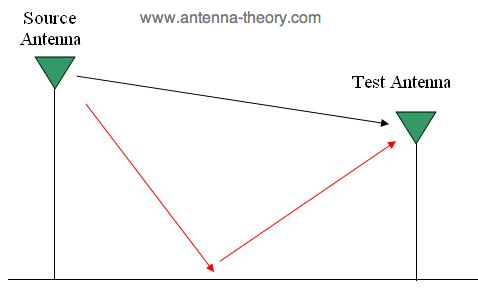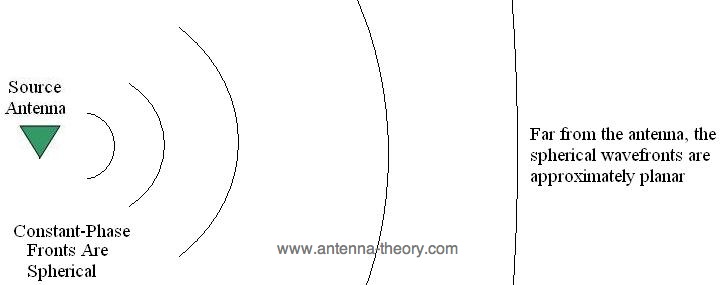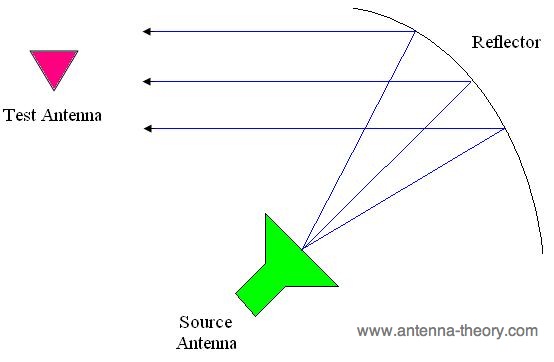For antenna testing, the most fundamental device is the VNA [Vector Network Analyzer].
The simplest type of VNA is a 1-port VNA, which is able to measure the impedance
of an antenna [which is equivalent to measuring
S11
and VSWR].
More of this will be discussed in the
impedance section.
A positioning system - This system is used to rotate the test antenna relative to the source antenna, to measure
the radiation pattern as a function of angle.
A block diagram of the above equipment is shown in Figure 1.

Figure 1. Diagram of required antenna measurement equipment.
These components will be briefly discussed. The Reference Antenna should of course radiate well at
the desired test frequency. Reference antennas are
often dual-polarized
horn antennas, so that horizontal and vertical
polarization can be measured at the same time.
The Transmitting System should be capable of outputing a stable known power level. The output
frequency
should also be tunable (selectable), and reasonably
stable (stable means that the frequency you get from the transmitter is close to the frequency you want, does not vary much with temperature). The transmitter should
contain very little energy at all other frequencies (there will always be some energy outside of the desired frequency, but there shouldn't be a lot of energy at harmonics, for instance).
The Receiving System simply needs to determine how much power is received from the test antenna.
This can be done via a simple power meter, which is a device for measuring RF (radio frequency) power and can be connected directly to the antenna terminals via a transmission line (such as a coaxial cable with N-type or SMA connectors). Typically the receiver is a 50 Ohm system, but can be
a different impedance if specified.
Note that the transmit/receive system is often replaced by a VNA. An S21 measurement
transmits a frequency out of port 1 and is records the received power at port 2. Hence, a
VNA is well-suited to this task; however it is not the only method of performing this task.
The Positioning System controls the orientation of the test antenna. Since we want to measure the radiation pattern
of the test antenna as a function of angle (typically in
spherical coordinates), we need to rotate the test antenna so that the source antenna illuminates the test antenna
from every possible angle. The positioning system is used for this purpose. In Figure 1, we show the AUT being rotated. Note that there are many ways to perform this rotation; sometimes the reference antenna is rotated, and sometimes both the reference and AUT antennas are rotated.
Now that we have all of the required equipment, we can discuss where to do the measurements.
Where is a good place for our antenna measurements? Maybe you would like to
do this in your garage, but the reflections from the walls, ceilings and floor would make your measurements inaccurate.
The ideal location to perform antenna measurements is somewhere in outer space, where no reflections can occur. However, because
space travel is currently prohibitively expensive, we will focus on measurement places that are on the surface of the Earth. An Anechoic Chamber can be used to isolate
the antenna test setup while absorbing reflected energy with RF absorbing foam.
.
Free Space Ranges (Anechoic Chambers)
Free space ranges are antenna measurement locations designed to simulate measurements that would be performed in space. That is,
all reflected waves from nearby objects and the ground (which are undesirable) are suppressed as much as possible. The most popular
free space ranges are anechoic chambers, elevated ranges, and the compact range.
Anechoic Chambers
Anechoic chambers are indoor antenna ranges. The walls, ceilings and floor are lined with special electromagnetic wave absorbering
material. Indoor ranges are desirable because the test conditions can be much more tightly controlled than that of outdoor ranges.
The material is often jagged in shape as well, making these chambers quite interesting to see. The jagged triangle
shapes are designed so that what is reflected from them tends to spread in random directions, and what is added together from all
the random reflections tends to add incoherently and is thus suppressed further. A picture of an anechoic chamber is shown in
the following picture, along with some test equipment:

The drawback to anechoic chambers is that they often need to be quite large. Often antennas need to be several wavelengths away
from each other at a minimum to simulate
far-field conditions.
Hence, for lower frequencies with large wavelengths we need very large chambers, but cost and practical
constraints often limit their size. Some defense contracting companies that measure the Radar Cross Section of large airplanes
or other objects are known to have anechoic chambers the size of basketball courts, although this is not ordinary. Universities
with anechoic chambers typically have chambers that are 3-5 meters in length, width and height. Because of the size constraint, and because
RF absorbing material typically works best at UHF and higher, anechoic chambers are most often used for
frequencies above 300 MHz.
Elevated Ranges
Elevated Ranges are outdoor ranges. In this setup, the source and antenna under test are mounted above the ground. These antennas
can be on mountains, towers, buildings, or wherever one finds that is suitable. This is often done for very large antennas or at low
frequencies (VHF and below, <100 MHz) where indoor measurements would be intractable. The basic diagram of an elevated range is shown
in Figure 2.

Figure 2. Illustration of elevated range.
The source antenna (or reference antenna) is not necessarily at a higher elevation than the test antenna, I just showed it that way here. The line of sight (LOS)
between the two antennas (illustrated by the black ray in Figure 2) must be unobstructed. All other reflections (such as the red
ray reflected from the ground) are undesirable. For elevated ranges, once a source and test antenna location are determined, the test
operators then determine where the significant reflections will occur, and attempt to minimize the reflections from these surfaces.
Often rf absorbing material is used for this purpose, or other material that deflects the rays away from the test antenna.
Compact Ranges
The source antenna must be placed in the far field of the test antenna. The reason is that the wave received by the test antenna
should be a plane wave for maximum accuracy. Since antennas radiate spherical waves, the antenna needs to be sufficiently far
such that the wave radiated from the source antenna is approximately a plane wave - see Figure 3.

Figure 3. A source antenna radiates a wave with a spherical wavefront.
However, for indoor chambers there is often
not enough separation to achieve this. One method to fix this problem is via a compact range. In this method, a source antenna
is oriented towards a reflector, whose shape is designed to reflect the spherical wave in an approximately planar manner. This
is very similar to the principle upon which a
dish antenna operates. The basic operation
is shown in Figure 4.

Figure 4. Compact Range - the spherical waves from the source antenna are reflected to be planar (collimated).
The length of the parabolic reflector is typically desired to be several times as large as the test antenna. The source antenna
in Figure 4 is offset from the reflector so that it is not in the way of the reflected rays. Care must also be exercised
in order to keep any direct radiation (mutual coupling) from the source antenna to the test antenna.
Next: Antenna Radiation Pattern Measurements
Antenna Theory (Home)
Top: Antenna Measurements
This page on antenna measurements and antenna testing is copyrighted, but can be reproduced
without permission from the author, just reference the URL source.
Copyright antenna-theory.com, 2009-2020. Antenna Measurements.

